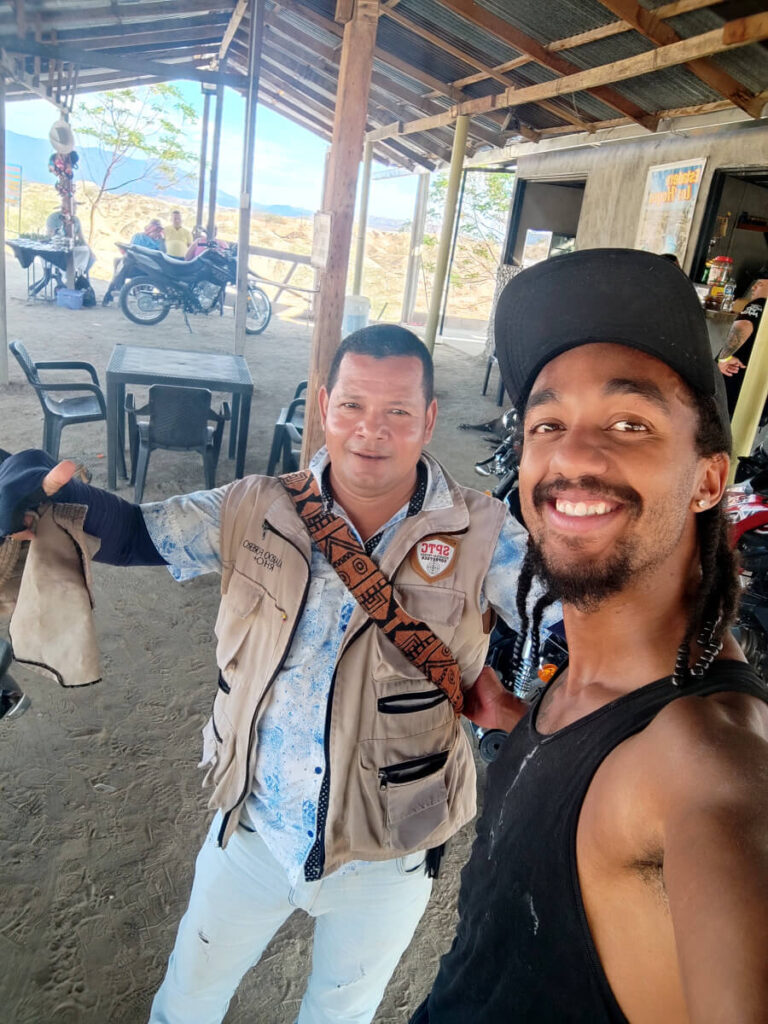Colombia, a land of beautiful landscapes and diverse terrains, invites adventurers to explore its nature on foot. In this blog post, you’ll learn helpful information about hiking in Colombia, an overview of top destinations, budget considerations, the necessity of a tour guide, and tips about local food along the way.
From the shores of Tayrona National Park to the slopes of the Galeras volcano, the views of Cocora Valley, and the trails of Sierra Nevada, each destination promises a unique hiking experience. Discover the secrets of Colombia’s famous and not-so-famous hiking spots with the tools and tips to transform your adventure into an unforgettable journey.
Table of Contents
Which places to hike?
Colombia is a land of unparalleled beauty and offers hikers diverse landscapes that bring good surprises. From dense forests near the Caribbean shores to deserts and waterfalls, this South American gem is perfect for hiking adventures.
Here is a list of options to consider when planning your next adventure. These are both famous and off-the-beaten destinations that will show you the diversity of the country’s landscapes.
Hiking in Colombia: Tayrona National Park
Tayrona National Park is a place where forests meet the Caribbean Sea on a multiple-day trek or a day tour. Adventurers looking for a more extended experience can do a 3-day trek from Calabazo to the El Zaino park entrance.
In this adventure, you will hike around 38km and sleep in eco-lodges, where hammocks or bungalows are the available options. I stayed the first night in the Eco Lodge Teyumakke, where the sea view from the hammocks was magical. It was a great stay in the Park. I won’t recommend the lodge I stayed on the second night (EcoCamping Lui) in Arrecifes because I wouldn’t say I liked it that much.
The forest changes during the trek, splitting into four different types: Thorny Forest, characterized by spiky vegetation, featuring prominent species like the trupillo, a symbolic tree of the region, and cacti from the semi-arid zone. Dry Forest: Regarded as the best-preserved in South America, home to slow-growing trees, including the endangered ebony tree valued for its timber.
As for the last two types of forest: Humid Forest, Occupying the most significant area, it thrives in the Park’s rainy zone. Marked by tall trees with large leaves that help regulate excess water. The last one is the Cloud Forest, Distinguished by a high concentration of surface mist, unique for being found at just 900 meters above sea level. In Arrecifes, mornings and twilight unveil a mist layer retained by small mountains.
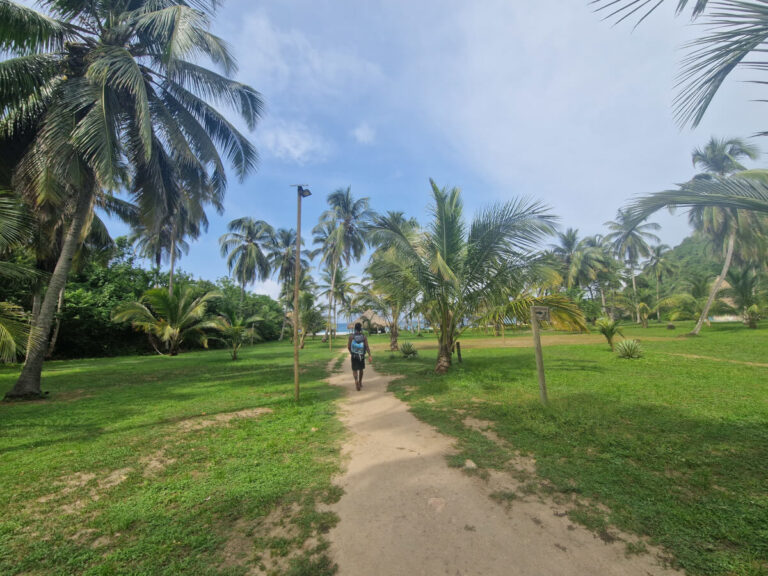
Fauna in Tayrona
Another highlight of Tayrona is the diverse fauna, and it is fascinating to hear the howler monkeys while silently hiking in the park. At first, they can be scary, but later, you realize they are not aggressive. Most of the time, they are howling for territorial protection (let’s not forget that we are invading their place).
Besides the monkeys, plenty of spiders, snakes, jaguars, and crabs are near the beach. Tayrona is a beautiful place for birdwatchers, with more than 300 avian species.
If you are looking for a smaller adventure, doing a day tour from El Zaino to Cabo San Juan is possible. It’s the most famous hike in Tayrona and the most touristic, so expect to see many people on the way. There are also a few sellers on the main viewpoints of this hike, selling “helados”(A type of ice with fruit flavor added).
Trekking for three days in Tayrona is the best way to immerse in the park thoroughly, visiting each part of it and exploring its beaches. It was my favorite place while hiking in Colombia!!
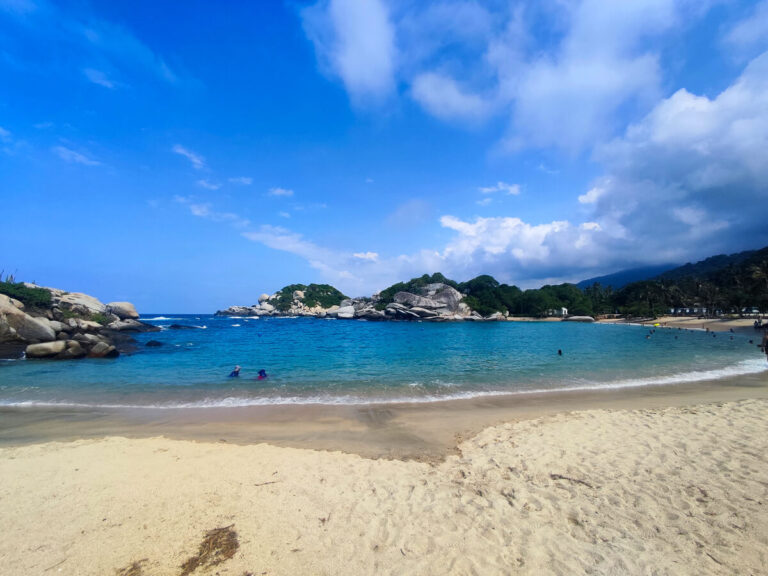
Hiking in Colombia: Galeras Volcano
Galeras is an active stratovolcano located in the Colombian Andes near the city of Pasto. It is one of Colombia’s most active volcanoes, with periodic eruptions throughout its history. The volcano reaches an elevation of approximately 4,276 meters above sea level, higher than the tallest volcanoes in Central America, making it a challenging yet rewarding destination. A few days of acclimatization is a good idea to avoid having surprises during the hike.
You can witness the impressive volcanic crater at the summit, which occasionally emits gases; it is always a good idea to check the local news to know if you can go to the summit—the panoramic views from the top offer a breathtaking glimpse of the surrounding landscapes.
The hike to the summit of Galeras is challenging and suitable for experienced hikers and those acclimated to high altitudes. The trail involves steep ascents, rocky terrain, and changes in weather conditions. As you get close to the summit, the weather quickly gets cold.
It is possible to hike to the summit without a guide. Just make sure to have an excellent app to track the route. I went there alone and lost the trail several times, mostly when getting close to the summit. In my case, the vegetation was burned, so finding the right path was challenging even with the route.
Climbing Galeras offers a physical challenge and a chance to witness the dynamic forces of nature in a captivating volcanic setting. The views of Pasto and Genoy from the summit are very rewarding, making this destination a good choice when hiking in Colombia.
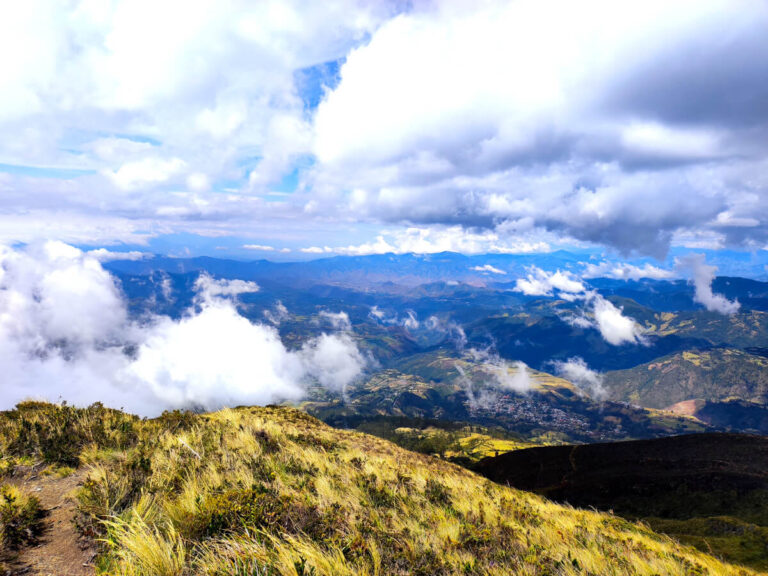
Hiking in Colombia: Minca
Nestled in the Sierra Nevada mountains, Minca sits approximately 650 meters above sea level, offering a cool climate among the tropical surroundings. There are several waterfalls around Minca, Marinka waterfall being one of the most visited. Those looking for a nice viewpoint will enjoy a hike to Los Pinos, which reveals a panorama of the surrounding mountains and the caribbean sea.
In Minca is one of the highlights of hiking in Colombia, the famous Lost City Trek that will lead you through ancient trails, river crossings and indigenous villages revealing the fascinating archaeological site of Ciudad Perdida.
The Los Pinos hike takes you through dense forests and culminates at the Los Pinos viewpoint, providing a spectacular view for sunrise or sunset. The trail is well-maintained, and the difficulty is moderate-hard in this 27km hike. On the trail to Los Pinos are waterfalls where you can take a break and appreciate nature. Marinka, Oido del Mundo, and Poco Azul are the most famous waterfalls in the area.
Marinka Waterfall is one of the shortest hikes in Minca, it’s perfect for a more chill hiking experince. The two waterfalls are a hidden gem surrounded by lush greenery where you encounters with exotic birds and butterflies.
Poco Azul has two waterfalls, where one is at the bottom of the first one. You should not skip a visit to the second one on the top. It requires a bit of climbing, but the reward at the top is worth it!! Generally, it’s crowded during the weekends and holidays, so avoid these days if possible. It’s a 1:30-hour hike from Minca, making it a perfect option for a half-day tour.
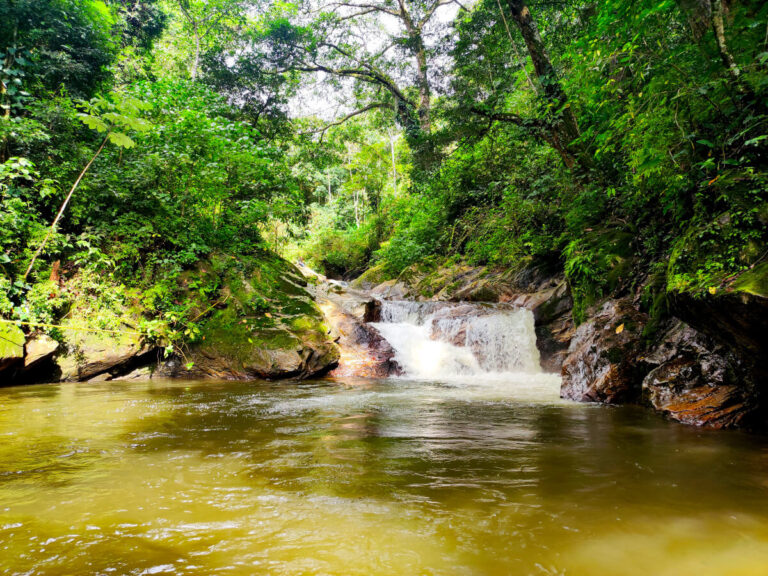
Hiking in Colombia: Tatacoa Desert
The Tatacoa Desert, located in the Huila region of Colombia, is a unique destination known for its landscapes and diverse geological formations. You should know it is not a desert but a dry tropical forest. The term “desert” is used due to its arid climate and distinctive landscape.
Fossils of ancient marine creatures have been discovered in the area, providing valuable insights into the region’s geological history. You’ll find the “Los Hoyos” area within the desert, a cactus forest with various cactus species.
Tatacoa experiences high daytime temperatures, often exceeding 40 degrees Celsius. Bring sufficient water, wear sunscreen, and plan your hikes during the cooler parts of the day.
The desert is easily accessible from the nearby towns of Villavieja and Neiva. While accommodations within the desert are limited, there are options in the surrounding areas for those looking to explore Tatacoa over multiple days. I stayed in Neiva and did a day tour visiting the Red and Gray deserts, returning to Neiva afterward.
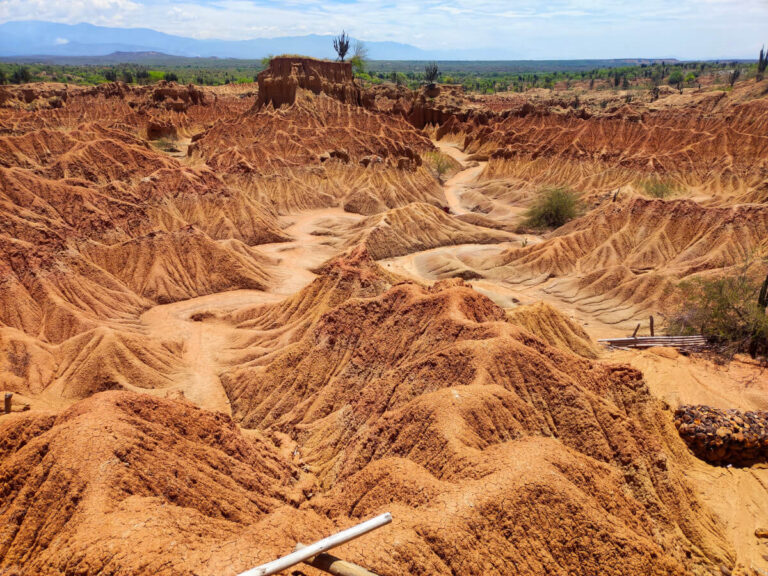
Hiking in Colombia: Jerico
Jericó, located in the department of Antioquia, Colombia, is a charming and historic town with colonial architecture and a rich cultural heritage. The village is also known for its religious heritage; it’s worth noting the Nuestra Senora de Las Mercedes Cathedral, located at the main square in the town.
Jerico is also part of the strong coffee culture in Colombia. There are several coffee plantations around the town, so you will have a chance to taste high-quality Colombian coffee. You can find coffee tours to learn about making the famous Colombian coffee.
As for hiking in Colombia, the Mirador Las Nubes is one of the town’s hiking highlights. The views from the viewpoint of Las Nubes Park are gratifying. You can do a short hike to the viewpoint and return to Jerico or extend your hike by visiting Pueblorrico.
Once in Pueblorrico, you can find transportation back to Jerico or hike through the same path back to Jerico. I enjoyed hiking from Jerico to Pueblorrico through the Las Nubes park. You can find my route here in this link.
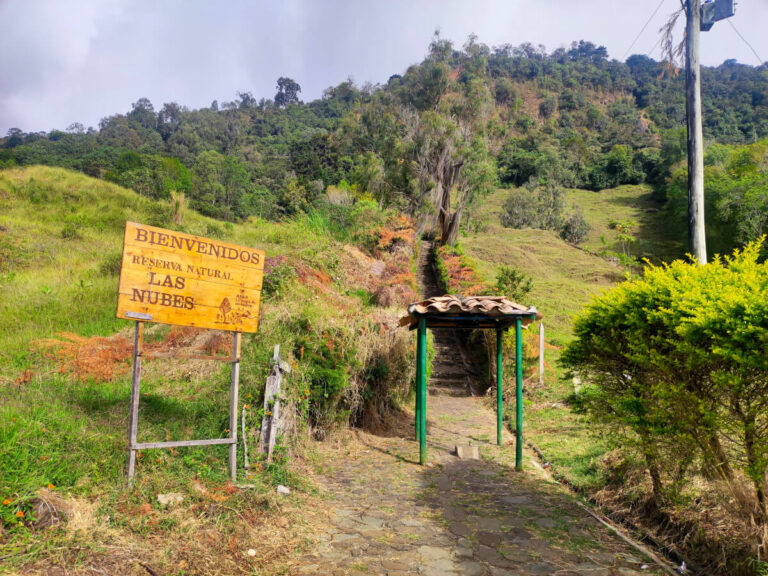
Hiking in Colombia: Jardin
Jardín, situated in the department of Antioquia, Colombia, is a charming town renowned for its natural beauty and outdoor activities. The town is known for its well-preserved colonial architecture, characterized by brightly colored houses, intricate balconies, and cobblestone streets.
The town is surrounded by lush hills and mountains, offering different hiking trails. The 7 Cascadas circuit is a famous trail that passes by seven waterfalls and viewpoints where you can connect with nature. Another trail is the hike to the Cristo Rey, located a few km from Jardin.
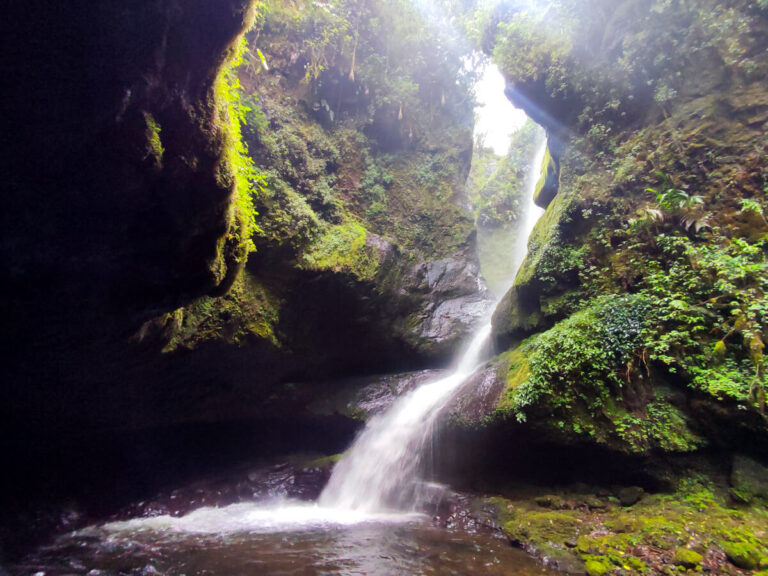
Hiking in Colombia: Cocora Valley
Cocora Valley is located in the Quindío department of Colombia, near Salento. It is part of the Los Nevados National Natural Park in the Andean region. The Valley is renowned for hosting the world’s tallest palm trees, the Quindío wax palms. These towering trees, reaching up to 60 meters in height, create a breathtaking landscape.
Los Nevados National Park offers more options for hiking in Colombia, including visits to the El Encanto Lake and the thermal waters of Del Canon and Estrella de Agua. Hikes vary from day tours to multiple two/three days, where you must bring your tent and supplies.
It’s easy to reach the Valley from Salento, an excellent place to set up your base for this adventure. Several drivers offer round-trip rides to the Valley in the center of the town.
Along the hiking trail in Cocora is the Acaime Hummingbird Sanctuary. This is a popular stop where hikers can rest, enjoy a cup of Colombian coffee, and observe numerous hummingbird species in their natural habitat.
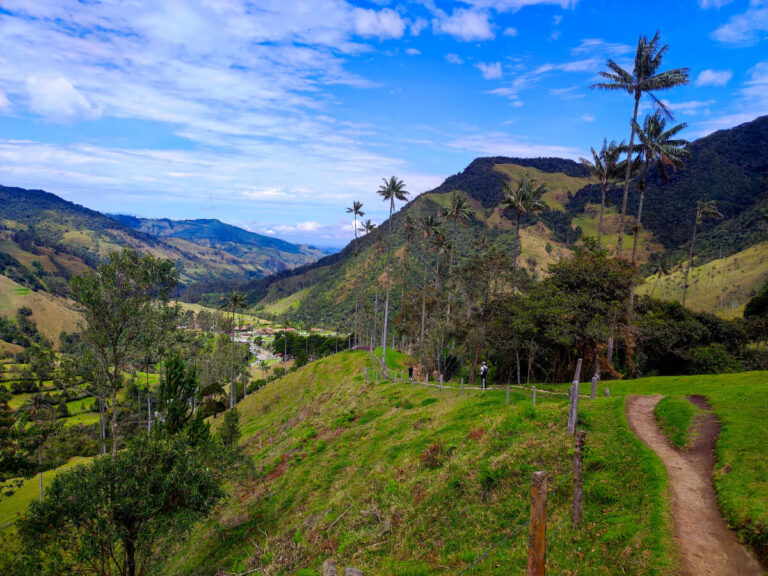
Hiking in Colombia: San Agustin
San Agustín, located in the Huila department of Colombia, is a UNESCO World Heritage site renowned for its archaeological treasures and stunning natural landscapes. The town is home to the San Agustín Archaeological Park.
The Archaelogical Park is a UNESCO-listed site that features South America’s largest religious monuments and megalithic sculptures. The park showcases mysterious statues, tombs, and other archaeological wonders dating back to ancient pre-Columbian cultures. The hike in the park is not demanding and you can visit the museum at the park entrance, before starting the hike.
San Agustín is surrounded by lush landscapes, making it an excellent destination for hiking adventures. The town is a gateway to various hiking trails that lead to archaeological sites, waterfalls, and scenic viewpoints.
Los Cinco is a small waterfall located a bit outside of San Agustin, the hike is not challenging, which makes it a perfect destination for half-day tour.
The trail to La Chaquira provides a scenic walk to a viewpoint overlooking the Magdalena River. You will find a sacred site with engraved stones and a breathtaking view.
For those seeking a more adventurous hike, the trail to Salto de Bordones leads to one of the highest waterfalls in Colombia. The hike offers amazing views of the waterfall and the surrounding landscape.

Do you need a guide?
Most of the hikes mentioned in this article don’t require a guide. There are exceptions, like the Lost City Trek in Minca, where booking a tour with one of the authorized tour agencies is necessary, like the Inca Trail in Peru.
Nevado del Tolima is a 4-day trek in the Los Nevados National Park, where the recommendation is to have a local guide with you. The harsh weather conditions and other possible issues require someone experience to guide you.
The hiking trails in Colombia are generally well-signalized; people are very kind and will gladly help you with some directions if needed. Maps.me works well, and many people (myself included) also uploaded tracks on Wikiloc; these two apps combined are great tools to help you in your adventures if you are tight on your budget or to hike independently.
If you can afford a local guide and the destination interests you, it’s a good idea to tour with one. It will help them, and you will get more information about the local destination. Feel free to go to a place and find a local guide, talk to the people in your accommodation, and surely they will recommend an excellent local guide.
The difference in price booking a local guide on the spot versus through some tour agency online was big in my experience. So my approach is always to arrive at the destination first, then start talking to the local people, asking about guides. It has been proven a great way to save some bucks and practive spanish.
What about food?
Food is very diverse in Colombia, in different regions you will find specific dishes that are their signature. In Salento, for example, the infamous Patacon con todo is a common dish that adds meat, cheese and salad on top of a big patacon.
In every village or town you visit, you will find many markets, local restaurants and local people selling food in the street (my favorite way to get food for a hike!!). So feel free to choose the option that suits you better.
Vegetarian options can be tough in small towns and villages, still, some places might surprise you. I have found good vegetarian meals in Jardin and Salento. My feelings are that Colombia is slowly becoming a more vegan/vegetarian friendly country. There’s a lot of work in front but it is going on a good direction.
Some hikes you can find food to buy on the way, like the Los Pinos hike in Minca. This hike passes by a couple of houses where locals prepare empanadas or whole meals for tourists and local workers.
Is hiking in Colombia budget-friendly?
Oh yes!! Hiking in Colombia can be very budget-friendly if you use the available budget-friendly options and apply some tricks I will explain in this section.
Transportation between cities is not expensive, and the same applies to local buses and Chivas (a very particular type of bus found in rural Colombia). Buying bus tickets at the terminals won’t be overcharged because the price is fixed. However, pay attention when using local minivans or Chivas; ask a local for the cost of the ride.
Unfortunately, in Colombia, the price of many things changes based on the appearance of the buyer. I always find a local nearby and ask them if they know the cost of anything I need to buy. I know it can be unpleasant to do that constantly, but that’s how to avoid being charged more.
It’s good to buy things from a seller on a bus only if they announce the price upfront. If they don’t announce the price, ask a passenger or wait for someone to buy it and check how much they paid. I had a situation where a seller told me that a bag with snacks was 5k COP, and a few seconds later, he sold the same bag to a local on the bus for 2k COP.
When it comes to guided tours, as I explained in this section, the best approach is to arrive at the destination and ask around about local tour guides. Booking guided tours online is more expensive in Colombia.
Some places charge an entrance fee, and it’s always a fair price based on the park’s size and infrastructure. Entrance prices in these parks are fixed so that you won’t be ripped off.

What about transportation?
Flying in Colombia has been much cheaper in the last few years. Avianca is leading the offers of domestic flights in the country, and you can find good deals even if you book a few weeks before the flight.
Traveling by bus in Colombia is okay. It is not better than Peru or Ecuador but still pretty good. If you travel between villages, like from Jerico to Jardin, you will find a bumpy ride in front of you since the road conditions could be better.
My experience traveling from north to south of the country was positive. It’s always better to avoid traveling with minivans. They consistently drive very fast, making the van shake a lot, which can be unpleasant.
Of all the bus companies I use on my trips to Colombia, Expreso Brasilia was by far the best!! The staff was very polite, and the buses were new. The best website to find bus tickets for your adventure is RedBus.
Tips about hiking in Colombia
It’s very fun to hike in Colombia but to guarantee a great experience I have some tips for you that helped me avoiding issues and I’m pretty sure that will help you as well:
- Do a deep research about the place where you want to go in order to get more info about the weather, entrance conditions (The Lost City is closed every year during the month of September) and the available transportation.
- Wear sturdy and comfortable hiking boots with good traction, as some trails may be uneven or slippery.
- Dress in layers, considering the inconsistent weather conditions in the country. Bring a waterproof jacket and quick-drying clothing.
- Stay hidrate. Some places like Cocora Valley have plenty of water sources available, other like Galeras don’t have any water source so bring plenty of water with you.
- Apply sunscreen, wear a hat and sunglasses to protect yourself from the strong Colombian sun, especially at higher elevations.
- If hiking in higher altitudes, like in Galeras, take time to acclimate. Consider spending a day or two at a lower altitude before attempting the hike.
- While many Colombians in tourist areas may speak English, learning basic Spanish phrases can be helpful, especially if you’re venturing into less touristy regions.
- Respect nature and put all of your trash in your backpack to dispose later when you are back to the city/town/village.
Conclusion
This article was an overview of the hiking in Colombia. The goal was to provide a general view of places you can visit so you can later research them and prepare yourself better.
Besides all the places mentioned, there are more places to hike; Colombia offers so much for hikers that one can spend months exploring nature.
I hope you have a good idea about the hiking scene in Colombia.
See you on the next adventure.
Bye!!

